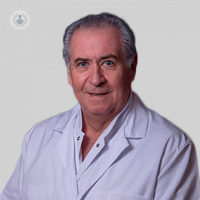Comprehensive treatment of obesity
Written by:Obesity is a disease that can be prevented and cured. To prevent it is necessary to lead a healthy lifestyle in which the eating habits are correct and are combined with moderate physical exercise. But, in some cases, this is not enough. That is when we resort to the integral treatment of obesity, which includes:
- Balanced diet , individualized and low in calories.
- Physical Exercise adjusted to each need and progressive with routines adapted to the patient.
- Medical treatment controlled by specialists.
In the case that is required, the intragastric balloon can be used as a temporary aid to the dietary follow-up and if this is not enough you can go to the surgical treatment , called metabolic and obesity surgery. Let's see in more detail what these two treatments consist of.

Intragastric balloon
It is the placement of a balloon (silicone, smooth and spherical) in the stomach that is inflated with 500 cc. of liquid. The placement of the intragastric balloon is done by endoscopy and with the patient sedated. It is recommended as a temporary aid for the modification of the feeding behavior in a selected group of patients that require losing weight in a controlled way.
It is effective for the short-term management of obesity because it reduces the sensation of hunger and gives a sensation of early satiety in meals, although it is essential to follow a series of dietary guidelines to achieve the expected weight loss.
The adaptation period is usually 48-72 hours, in which nausea, vomiting and belching will appear. And the balloon can remain in the stomach for six months, a period in which it is advisable to modify dietary habits, follow the prescribed diet and exercise regularly. With all this joint program it is possible to lose between 18 and 22 kg. in the established time.
Metabolic and obesity surgery
Metabolic and obesity surgery is based on a set of surgical procedures that seek to correct and control the pathology associated with morbid obesity. This type of surgery alters the anatomy of the digestive system to eliminate excess weight of the patient. For this, the caloric contribution to the body is reduced by reducing the gastric capacity (decreasing the appetite and food intake) and the intestinal route is modified to avoid fat absorption. In turn, it stimulates the consumption of already formed fat in the body and prevents it from forming new.
Thus, it is possible to reduce the weight of the patient, who must be aware of the imperative that it is to maintain healthy diets and a healthy lifestyle to obtain successful long-term results, since bariatric surgery is not a definitive solution to morbid obesity if you do not end bad eating habits and adopt a healthy lifestyle.
It should be clear that surgery for the treatment of obesity is reserved for patients diagnosed with morbid obesity, over five years of evolution in which previous dietary and medical measures have failed. Regarding safety, bariatric surgery is safe, although due to the risks associated with obesity, major surgery is considered. Therefore, patients must be treated by a multidisciplinary group with the experience and knowledge necessary to achieve the best results.
After surgery, the amount of weight lost depends on the patient and the type of procedure performed. Patients who manage to modify their lifestyle and follow their treatment to the letter can achieve even greater weight loss. The maximum weight loss is achieved before 18 months with all interventions.
And although many patients do not reach their ideal weight, the weight loss (between 60% and 85%) produced by surgery is enough to significantly reduce the risk of developing complications related to obesity. You can even achieve the ideal weight if you follow a proper diet , appropriate physical activity and maintain a lifestyle adapted to the new situation. In any case, with the reduction of weight, the diseases associated with obesity are improved and the improvement of mobility and general resistance is achieved.. In addition, it improves self-esteem , humor , interpersonal relationships and the ability to work. It should be noted that some interventions of this type may require post-bariatric plastic surgery to solve the possible flaccidity that affects the skin.


